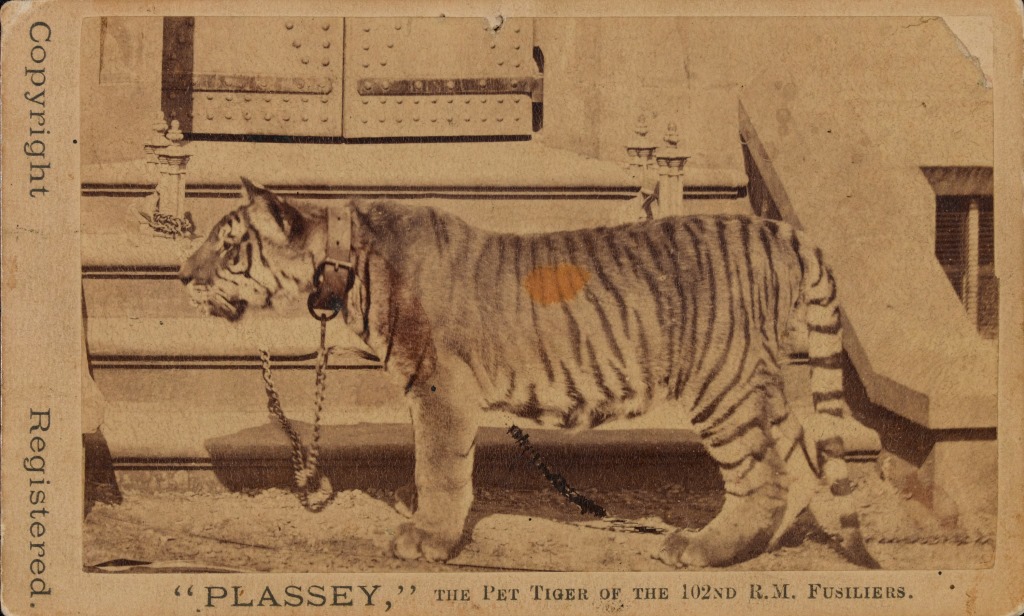 Regiments of the British Army have kept animals as mascots since the 18th century to work with them, bring luck and strengthen morale. Mascots are different to soldier’s pets and working animals, in that they are adopted and maintained for purely ceremonial reasons.
Regiments of the British Army have kept animals as mascots since the 18th century to work with them, bring luck and strengthen morale. Mascots are different to soldier’s pets and working animals, in that they are adopted and maintained for purely ceremonial reasons.
There are both official and unofficial mascots in the British Army. The unofficial kind are actually more like a ceremonial pet, which is fed and housed at the unit’s expense; whereas official mascots are entitled to the services of the Royal Army Veterinary Corps, and are looked after with public money.
Both kinds are treated like any other soldier, and share the dangers, tedium and camaraderie of army life. But official mascots also have a regimental number and rank, and can even be promoted or demoted.
There are currently 17 mascots in the British Army, belonging to 11 different regiment and corps. Only 10 of these animals are official recognised, the rest are ceremonial pets.
Welsh billy goats
The Royal Welsh, and their predecessor units, are believed to have started the custom of adopting mascots in 1775 at Bunker Hill during the American War of Independence (1775-83). Legend has it that a wild goat strayed on to the battlefield and eventually led the Royal Welsh Fusiliers' colour party from the field. A goat has served with the Royal Welsh ever since. From 1884, they obtained their mascots as a gift from the monarch after Queen Victoria presented the regiment with a Kashmir goat from her royal herd.
All of the Royal Welsh’s goats have been called William or Billy. The most notorious of these was Billy Windsor, who served from 2001 to 2009. He earned a demotion for marching out of line and trying to headbutt the battalion drummers while leading a parade in front of the Queen. His demotion meant that other soldiers were no longer expected to salute him, but he fortunately still received his daily ration of two cigarettes a day to eat and Guinness to drink.
Billy eventually regained his old rank and retired with full honours to Whipsnade Zoo in 2009. Soldiers from the battalion lined the route from his pen to the trailer as he left their camp for the last time.
An Indian tiger
Some regiments choose mascots that symbolise a part of their unit's history and character. Plassey was a Bengal tiger who belonged to the 102nd Regiment of Foot (Royal Madras Fusiliers) in the 1860s. The cap badge of the unit depicted a tiger, which was an Indian symbol of strength, grace and power. He was also named after the famous Battle of Plassey in 1757, which the 102nd's predecessors had taken part in.
In 1870, when the 102nd were shipped to England, Plassey came with them. He travelled in the company of two leopards and lived, unchained, at the regimental base in Dover. But after frightening the local people once too often, he was reluctantly given a new home at London Zoo, where he died in 1877.
Staffordshire terriers
Other regiment’s mascots are chosen for their connections to their home county. Since 1949, the various iterations of the Staffordshire Regiment have had a Staffordshire Bull Terrier named Watchman as their mascot. So far, five dogs have held the honour.
Watchman IV, who retired in 2010, had a particularly prestigious career. He got to meet the Queen at a remembrance service at Westminster Abbey, and behaved so well that he achieved the rank of colour sergeant, the same as his handler.
The current Watchman is a regimental pet, or unofficial mascot, so his upkeep is paid for by the Staffordshire Regimental Association. He lives at the home of the person who looks after him.
The medalled military mule
Like pets, some mascots are picked up while their regiments are serving on campaigns. This was the case with Jimson the mule, who started his military career carrying ammunition across difficult terrain in India and South Africa for 2nd Battalion, The Duke of Cambridge's Own (Middlesex Regiment).
After the Boer War of 1899-1902, Jimson was adopted by the unit and became their mascot. The men of the Middlesex appreciated his bravery and hard work so much that they sought special dispensation to bring him back to England. This was particularly remarkable, as quarantine rules often prevented horses and mules from returning from the battlefield.
Jimson was also given the India Medal in 1895 and the two Boer War campaign medals. As animals could not formally receive medals, it's likely that they were actually donated by a generous soldier, or were replicas specially made for him. Even so, Jimson remains the only mule ever to have received a military medal.
About the author
Emily Charles writes for the National Army Museum website, where she has published information exploring a range of topics about the history of the British Army.
The National Army Museum is a leading authority on the British Army and its impact on society past and present. Follow @NAM_London.
Pictured: Plassey, the pet tiger of the Royal Madras Fusiliers, 1870 (NAM. 1964-08-341-2)